A User’s Guide for the
CALMET Meteorological Model
(Version 5)
Prepared by:
Joseph S. Scire
Francoise R. Robe
Mark E. Fernau
Robert J. Yamartino
Earth Tech, Inc.
196 Baker Avenue
Concord, MA 01742
January 2000
Copyright © 1998, 1999,2000 by Earth Tech, Inc.
All Rights Reserved
�
TABLE OF CONTENTS
1. OVERVIEW . . . . . . . . . . . . . . . . . . . . . . . . . . . . . . . . . . . . . . . . . . . . . . . . . . . . . . . . . . . . . . . . . . . . 1-1
Background . . . . . . . . . . . . . . . . . . . . . . . . . . . . . . . . . . . . . . . . . . . . . . . . . . . . . . . . . . 1-1
Overview of the CALPUFF Modeling System . . . . . . . . . . . . . . . . . . . . . . . . . . . . . . . 1-3
Major Model Algorithms and Options . . . . . . . . . . . . . . . . . . . . . . . . . . . . . . . . . . . . 1-12
Summary of Data and Computer Requirements . . . . . . . . . . . . . . . . . . . . . . . . . . . . . 1-15
1.1
1.2
1.3
1.4
PAGE NO.
2.1
2.2
2. TECHNICAL DESCRIPTION . . . . . . . . . . . . . . . . . . . . . . . . . . . . . . . . . . . . . . . . . . . . . . . . . . . . . . 2-1
Grid System . . . . . . . . . . . . . . . . . . . . . . . . . . . . . . . . . . . . . . . . . . . . . . . . . . . . . . . . . . 2-1
Wind Field Module . . . . . . . . . . . . . . . . . . . . . . . . . . . . . . . . . . . . . . . . . . . . . . . . . . . . 2-3
2.2.1
Step 1 Formulation . . . . . . . . . . . . . . . . . . . . . . . . . . . . . . . . . . . . . . . . . . . . . . 2-3
2.2.2 Step 2 Formulation . . . . . . . . . . . . . . . . . . . . . . . . . . . . . . . . . . . . . . . . . . . . . . 2-8
. . . . . . . . . . . . . . . . . . . . . . . 2-17
2.2.3
. . . . . . . . . . . . . . . . . . . . . . . . . . . . . . . 2-19
Incorporation of Prognostic Model Output
2.2.3.1 Terrain Weighting Factor
2.3
Micrometeorological Model
2.3.1
2.3.2
. . . . . . . . . . . . . . . . . . . . . . . . . . . . . . . . . . . . . . . . . . . . 2-22
Surface Heat and Momentum Flux Parameters . . . . . . . . . . . . . . . . . . . . . . . 2-22
Three-dimensional Temperature Field . . . . . . . . . . . . . . . . . . . . . . . . . . . . . . 2-31
2.3.2.1 Overwater Temperatures . . . . . . . . . . . . . . . . . . . . . . . . . . . . . . . . . . 2-33
Precipitation Interpolation . . . . . . . . . . . . . . . . . . . . . . . . . . . . . . . . . . . . . . . 2-33
2.3.3
3. CALMET MODEL STRUCTURE . . . . . . . . . . . . . . . . . . . . . . . . . . . . . . . . . . . . . . . . . . . . . . . . . . . 3-1
Memory Management
. . . . . . . . . . . . . . . . . . . . . . . . . . . . . . . . . . . . . . . . . . . . . . . . . . 3-1
Structure of the CALMET Modules . . . . . . . . . . . . . . . . . . . . . . . . . . . . . . . . . . . . . . . 3-1
3.1
3.2
4. USER INSTRUCTIONS . . . . . . . . . . . . . . . . . . . . . . . . . . . . . . . . . . . . . . . . . . . . . . . . . . . . . . . . . . . 4-1
4.1 Meteorological Preprocessor Programs . . . . . . . . . . . . . . . . . . . . . . . . . . . . . . . . . . . . . . . . 4-1
4.1.1 READ62 Upper Air Preprocessor . . . . . . . . . . . . . . . . . . . . . . . . . . . . . . . . . . . . . 4-1
4.1.2 METSCAN Surface Data QA Program . . . . . . . . . . . . . . . . . . . . . . . . . . . . . 4-10
SMERGE Surface Data Meteorological Preprocessor . . . . . . . . . . . . . . . . . . 4-15
4.1.3
4.1.4
PXTRACT Precipitation Data Extract Program . . . . . . . . . . . . . . . . . . . . . . . 4-23
4.1.5 PMERGE Precipitation Data Preprocessor
. . . . . . . . . . . . . . . . . . . . . . . . . . 4-33
4.1.6 CALMM5 Program . . . . . . . . . . . . . . . . . . . . . . . . . . . . . . . . . . . . . . . . . . . . . 4-41
CALMM5 preprocessor . . . . . . . . . . . . . . . . . . . . . . . . . . . . 4-41
CALMM5 input . . . . . . . . . . . . . . . . . . . . . . . . . . . . . . . . . . 4-45
CALMM5 output
. . . . . . . . . . . . . . . . . . . . . . . . . . . . . . . . . 4-46
Geophysical Data Processors . . . . . . . . . . . . . . . . . . . . . . . . . . . . . . . . . . . . . . . . . . . . 4-67
TERREL Terrain Preprocessor . . . . . . . . . . . . . . . . . . . . . . . . . . . . . . . . . . . . 4-69
4.2.1
4.2.2
Land Use Data Preprocessors (CTGCOMP and CTGPROC) . . . . . . . . . . . . 4-78
4.2.2.1 Obtaining the Data
. . . . . . . . . . . . . . . . . . . . . . . . . . . . . . . . . . . . . . 4-78
4.2.2.2 CTGCOMP- the CTG land use data compression program . . . . . . . 4-78
4.2.2.3 CTGPROC - the land use preprocessor . . . . . . . . . . . . . . . . . . . . . . . 4-79
4.2.3 MAKEGEO . . . . . . . . . . . . . . . . . . . . . . . . . . . . . . . . . . . . . . . . . . . . . . . . . . 4-85
CALMET Model Files . . . . . . . . . . . . . . . . . . . . . . . . . . . . . . . . . . . . . . . . . . . . . . . . . 4-91
4.3.1 User Control File (CALMET.INP) . . . . . . . . . . . . . . . . . . . . . . . . . . . . . . . . . 4-95
4.1.6.1
4.1.6.2
4.1.6.3
4.2
4.3
�
4.3.2 Geophysical Data File (GEO.DAT) . . . . . . . . . . . . . . . . . . . . . . . . . . . . . . . 4-132
4.3.3 Upper Air Data Files (UP1.DAT, UP2.DAT,...)
. . . . . . . . . . . . . . . . . . . . . 4-144
4.3.4
Surface Meteorological Data File (SURF.DAT) . . . . . . . . . . . . . . . . . . . . . 4-149
4.3.5 Overwater Data Files (SEA1.DAT, SEA2.DAT, ...) . . . . . . . . . . . . . . . . . . 4-153
4.3.6
Precipitation Data File (PRECIP.DAT) . . . . . . . . . . . . . . . . . . . . . . . . . . . . 4-156
Preprocessed Diagnostic Model Data File (DIAG.DAT) . . . . . . . . . . . . . . . 4-160
4.3.7
4.3.8
Prognostic Model Data File (PROG.DAT)
. . . . . . . . . . . . . . . . . . . . . . . . . 4-164
4.3.9 MM4/MM5 Model Data File (MM4.DAT) . . . . . . . . . . . . . . . . . . . . . . . . . 4-166
4.3.10 Terrain Weighting Factor Data File (WT.DAT)
. . . . . . . . . . . . . . . . . . . . . 4-183
4.3.11 CALMET Output Files . . . . . . . . . . . . . . . . . . . . . . . . . . . . . . . . . . . . . . . . . 4-190
. . . . . . . . . . . . . . . . . . . . . . . . . . . . . 4-190
PRTMET Meteorological Display Program . . . . . . . . . . . . . . . . . . . . . . . . . . . . . . . 4-206
CALMET.DAT
4.3.11.1
4.4
5. REFERENCES . . . . . . . . . . . . . . . . . . . . . . . . . . . . . . . . . . . . . . . . . . . . . . . . . . . . . . . . . . . . . . . . . . 5-1
APPENDIX A
Subroutine/Function Calling Structure . . . . . . . . . . . . . . . . . . . . . . . . . . . . . . . . . . . . . . . . . . . . . . . . . A-1
APPENDIX B
Description of Each CALMET Subroutine and Function . . . . . . . . . . . . . . . . . . . . . . . . . . . . . . . . . . . B-1
APPENDIX C
Equations Used in Lambert Conformal Conversions . . . . . . . . . . . . . . . . . . . . . . . . . . . . . . . . . . . . . . C-1
APPENDIX D
The Universal Transverse Mercator (UTM) Grid . . . . . . . . . . . . . . . . . . . . . . . . . . . . . . . . . . . . . . . . . D-1
�
1. OVERVIEW
1.1
Background
As part of a study to design and develop a generalized non-steady-state air quality modeling system for
regulatory use, Sigma Research Corporation (now part of Earth Tech, Inc.), developed the CALPUFF
dispersion model and related models and programs, including the CALMET meteorological model. The
original development of CALPUFF and CALMET was sponsored by the California Air Resources Board
(CARB). Systems Application, Inc. (SAI) served as a subcontractor to Sigma Research with the
responsibility for developing the original wind field modeling component of the CALMET model.
The original design specifications for the modeling system included: (1) the capability to treat time-
varying point and area sources, (2) suitability for modeling domains from tens of meters to hundreds of
kilometers from a source, (3) predictions for averaging times ranging from one-hour to one year, (4)
applicability to inert pollutants and those subject to linear removal and chemical conversion mechanisms,
and (5) applicability for rough or complex terrain situations.
The modeling system (Scire et al., 1990a, 1990b) developed to meet these objectives consisted of three
components: (1) a meteorological modeling package with both diagnostic and prognostic wind field
generators, (2) a Gaussian puff dispersion model with chemical removal, wet and dry deposition,
complex terrain algorithms, building downwash, plume fumigation, and other effects, and (3)
postprocessing programs for the output fields of meteorological data, concentrations and deposition
fluxes.
In July, 1987, CARB initiated a second project with Sigma Research to upgrade and modernize the
Urban Airshed Model (UAM) to include state-of-the-science improvements in many of the key technical
algorithms including the numerical advection and diffusion schemes, dry deposition, chemical
mechanisms, and chemical integration solver. The new photochemical model, called CALGRID
(Yamartino et al., 1992; Scire et al., 1989), was integrated into the CALMET/CALPUFF modeling
framework to create a complete modeling system for both reactive and non-reactive pollutants. A third
component of the modeling system, a Lagrangian particle model called the Kinematic Simulation Particle
(KSP) model (Strimaitis et al., 1995; Yamartino et al., 1996), was developed under sponsorship of the
German Umweldbundesamt. All three models (CALPUFF, CALGRID, and KSP) are designed to be
compatible with the common meteorological model, CALMET, and share preprocessing and
postprocessing programs for the display of the modeling results.
In the early 1990s, the Interagency Workgroup on Air Quality Modeling (IWAQM) reviewed various
modeling approaches suitable for estimating pollutant concentrations at Class I areas, including the
I:\calmet\nov99\sect1.wpd
1-1
�
individual and cumulative impacts of proposed and existing sources on Air Quality Related Values
(AQRVs), Prevention of Significant Deterioration (PSD) increments, and National Ambient Air Quality
Standards (NAAQS). IWAQM consists of representatives from the U.S. Environmental Protection
Agency (EPA), U.S. Forest Service, National Park Service, and U.S. Fish and Wildlife Service. IWAQM
released a Phase I report (EPA, 1993a) which recommended using the MESOPUFF II dispersion model
and MESOPAC II meteorological model on an interim basis for simulating regional air quality and
visibility impacts. These recommendations were to apply until more refined (Phase 2) techniques could
be identified and evaluated. As part of the development of the Phase 2 recommendations, IWAQM
reviewed and intercompared diagnostic wind field models, tested the use of coarse gridded wind fields
from the Penn State/NCAR Mesoscale Model with four dimensional data assimilation (MM4) as input
into the diagnostic models, and evaluated the MESOPUFF II and CALPUFF modeling systems using
tracer data collected during the Cross-Appalachian Tracer Experiment (CAPTEX). The CAPTEX
evaluation results (EPA, 1995) indicated that by using the CALMET/ CALPUFF models with MM4 data,
performance could be improved over that obtained with the interim Phase I modeling approach. The
Phase 2 IWAQM report (EPA, 1998) recommends the use of the CALMET and CALPUFF models for
estimating air quality impacts relative to the National Ambient Air Quality Standards (NAAQS) and
Prevention of Significant Deterioration (PSD) increments. The U.S. EPA has proposed the CALPUFF
modeling system as a Guideline ("Appendix A") model for regulatory applications involving long range
transport and on a case-by-case basis for near-field applications where non-steady-state effects (situations
where factors such as spatial variability in the meteorological fields, calm winds, fumigation,
recirculation or stagnation, and terrain or coastal effects) may be important.
The CALMET and CALPUFF models have been substantially revised and enhanced as part of work for
IWAQM, U.S. EPA, the U.S.D.A. Forest Service, the Environmental Protection Authority of Victoria
(Australia), and private industry in the U.S. and abroad. The improvements to CALMET included
modifications to make it more suitable for regional applications such as the use of a spatially variable
initial guess field, an option for using hourly MM4 or MM5 gridded fields as a supplement to
observational data, the ability to compute Lambert conformal map factors, a modified mixing height
scheme, an option to use similarity theory to vertically extrapolate surface wind observations, an
enhanced algorithm to compute the three-dimensional temperature fields over water bodies, improved
initialization techniques, a refined slope flow parameterization, and an optional PC-based Graphical User
Interface (GUI) to facilitate model setup and execution and to provide access to on-line Help files.
Improvements to CALPUFF include new modules to treat buoyant rise and dispersion from area sources
(such as forest fires), buoyant line sources, volume sources, an improved treatment of complex terrain,
additional model switches to facilitate its use in regulatory applications, enhanced treatment of wind
shear through puff splitting, use of a probability density function (pdf) to describe dispersion during
convective conditions, and an optional GUI. CALPUFF has been coupled to the Emissions Production
I:\calmet\nov99\sect1.wpd
1-2
�
Model (EPM) developed by the Forest Service through an interface processor. EPM provides time-
dependent emissions and heat release data for use in modeling controlled burns and wildfires.
1.2
Overview of the CALPUFF Modeling System
The CALPUFF Modeling System includes three main components: CALMET, CALPUFF, and
CALPOST and a large set of preprocessing programs designed to interface the model to standard,
routinely-available meteorological and geophysical datasets. In the simplest terms, CALMET is a
meteorological model that develops hourly wind and temperature fields on a three-dimensional gridded
modeling domain. Associated two-dimensional fields such as mixing height, surface characteristics, and
dispersion properties are also included in the file produced by CALMET. CALPUFF is a transport and
dispersion model that advects “puffs” of material emitted from modeled sources, simulating dispersion
and transformation processes along the way. In doing so it typically uses the fields generated by
CALMET, or as an option, it may use simpler non-gridded meteorological data much like existing plume
models. Temporal and spatial variations in the meteorological fields selected are explicitly incorporated
in the resulting distribution of puffs throughout a simulation period. The primary output files from
CALPUFF contain either hourly concentrations or hourly deposition fluxes evaluated at selected receptor
locations. CALPOST is used to process these files, producing tabulations that summarize the results of
the simulation, identifying the highest and second highest 3-hour average concentrations at each receptor,
for example. When performing visibility-related modeling, CALPOST uses concentrations from
CALPUFF to compute extinction coefficients and related measures of visibility, reporting these for
selected averaging times and locations.
Most applications of the system are built around these three components. To enhance their functionality,
a PC-based GUI is provided for each major component. The GUIs can be used to prepare the control file
that configures a run, execute the corresponding component model, and conduct file management
functions. The GUIs also contain an extensive help system that makes much of the technical information
contained in this manual available to the user on-line. The modeling system may also be setup and run
without the aid of the GUIs. The control file for each component is simply a text file that is readily
edited, and it contains extensive information about model options, default values, and units for each
variable.
In addition to CALMET, CALPUFF, CALPOST, and their corresponding GUIs, the modeling system
interfaces to several other models, which is facilitated by several preprocessors and utilities. Figure 1-1
displays the overall modeling system configuration. Four of the models shown in Figure 1-1 are external
models that are not included in the CALPUFF system, but they can be interfaced with CALPUFF
modules:
I:\calmet\nov99\sect1.wpd
1-3
�
Figure 1-1.
Overview of the program elements in the CALMET/CALPUFF modeling system. Also
shown are the associated CALGRID photochemical model, the KSP particle model, and
the MM5/MM4 and CSUMM meteorological models.
I:\calmet\nov99\sect1.wpd
1-4
�
MM5/MM4 (Penn State/NCAR Mesoscale Model) is a prognostic wind field model with four
dimensional data assimilation (Anthes et al., 1987; Grell et al., 1996). The diagnostic wind field
model within CALMET contains options that allow wind fields produced by MM5 or MM4 to be
used as an initial guess field, or pseudo-observations and combined with other data sources as
part of the CALMET objective analysis procedure. An interface program (CALMM5) converts
the MM5 data into a form compatible with CALMET.
CSUMM (a version of the Colorado State University Mesoscale Model) is a primitive equation
wind field model (Kessler, 1989) which simulates mesoscale airflow resulting from differential
surface heating and terrain effects. Various options for using CSUMM output with CALMET
are provided.
The other two external models may use the output file from CALMET for their meteorological fields:
CALGRID is an Eulerian photochemical transport and dispersion model which includes
modules for horizontal and vertical advection/diffusion, dry deposition, and a detailed
photochemical mechanism.
KSP is a multi-layer, multi-species Lagrangian particle model that simulates transport,
dispersion, and deposition using explicit kinematic simulation (KS) of the larger transportive and
dispersive eddies in the atmosphere.
The components in Figure 1-1 that are included in the system are:
CALMET is a meteorological model which includes a diagnostic wind field generator
containing objective analysis and parameterized treatments of slope flows, kinematic terrain
effects, terrain blocking effects, and a divergence minimization procedure, and a micro-
meteorological model for overland and overwater boundary layers.
CALPUFF is a non-steady-state Lagrangian Gaussian puff model containing modules for
complex terrain effects, overwater transport, coastal interaction effects, building downwash, wet
and dry removal, and simple chemical transformation.
CALPOST is a postprocessing program with options for the computation of time-averaged
concentrations and deposition fluxes predicted by the CALPUFF and CALGRID models.
CALPOST computes visibility impacts in accordance with IWAQM recommendations and the
current Federal Land Managers’ Air Quality Related Values Workgroup (FLAG
recommendations.
I:\calmet\nov99\sect1.wpd
1-5
�
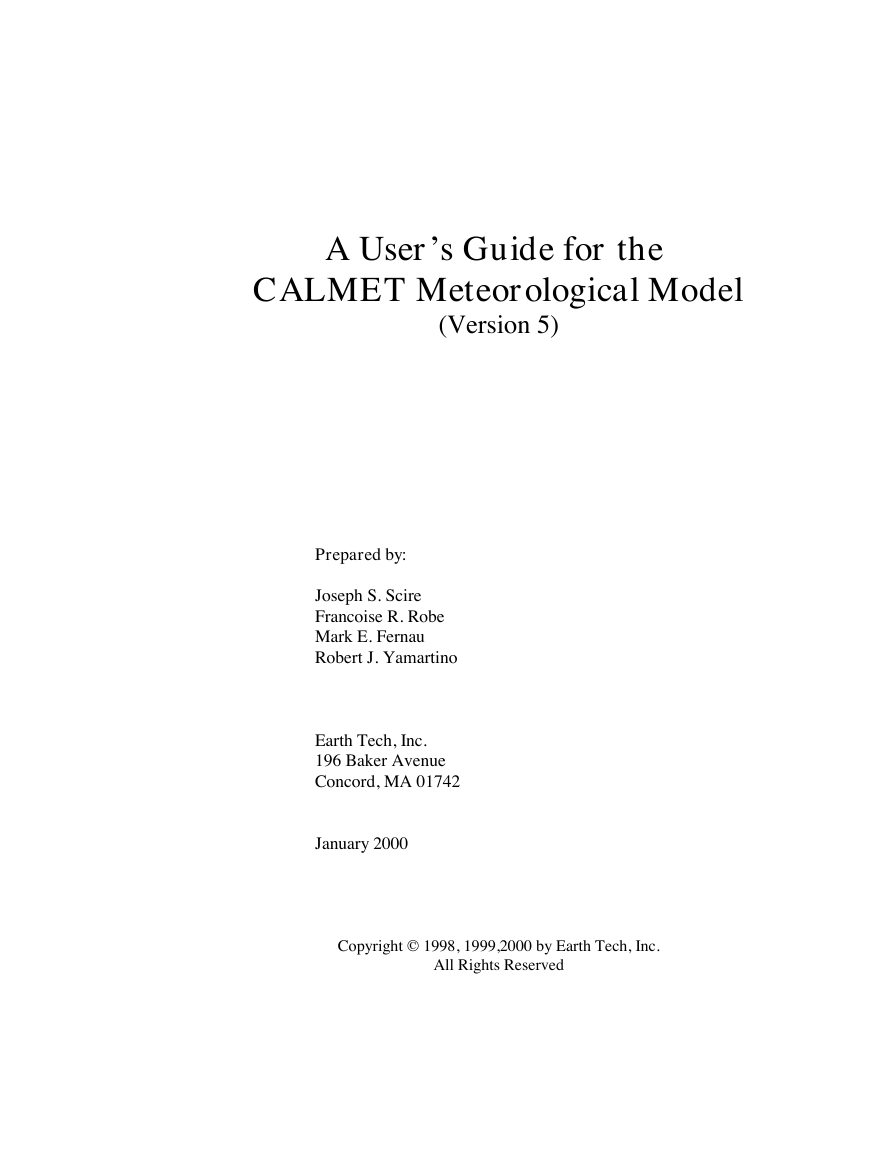
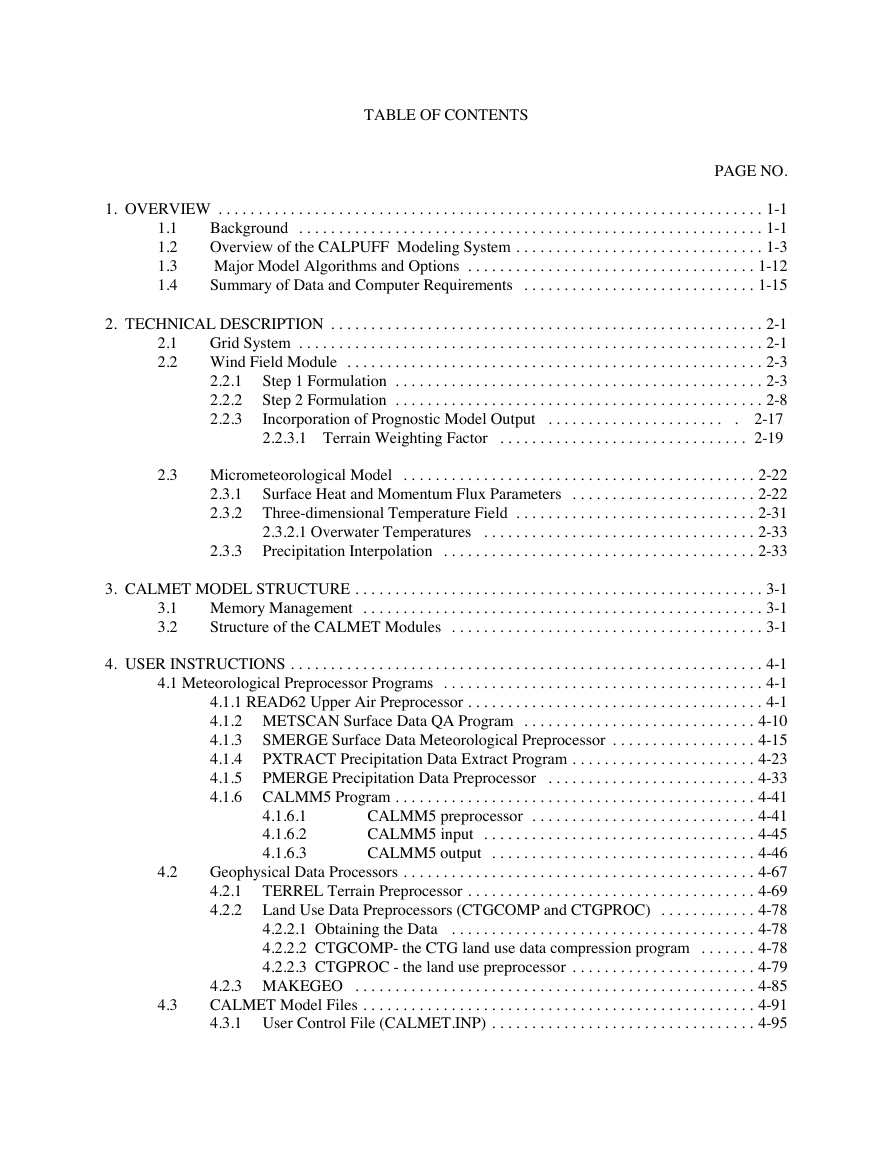
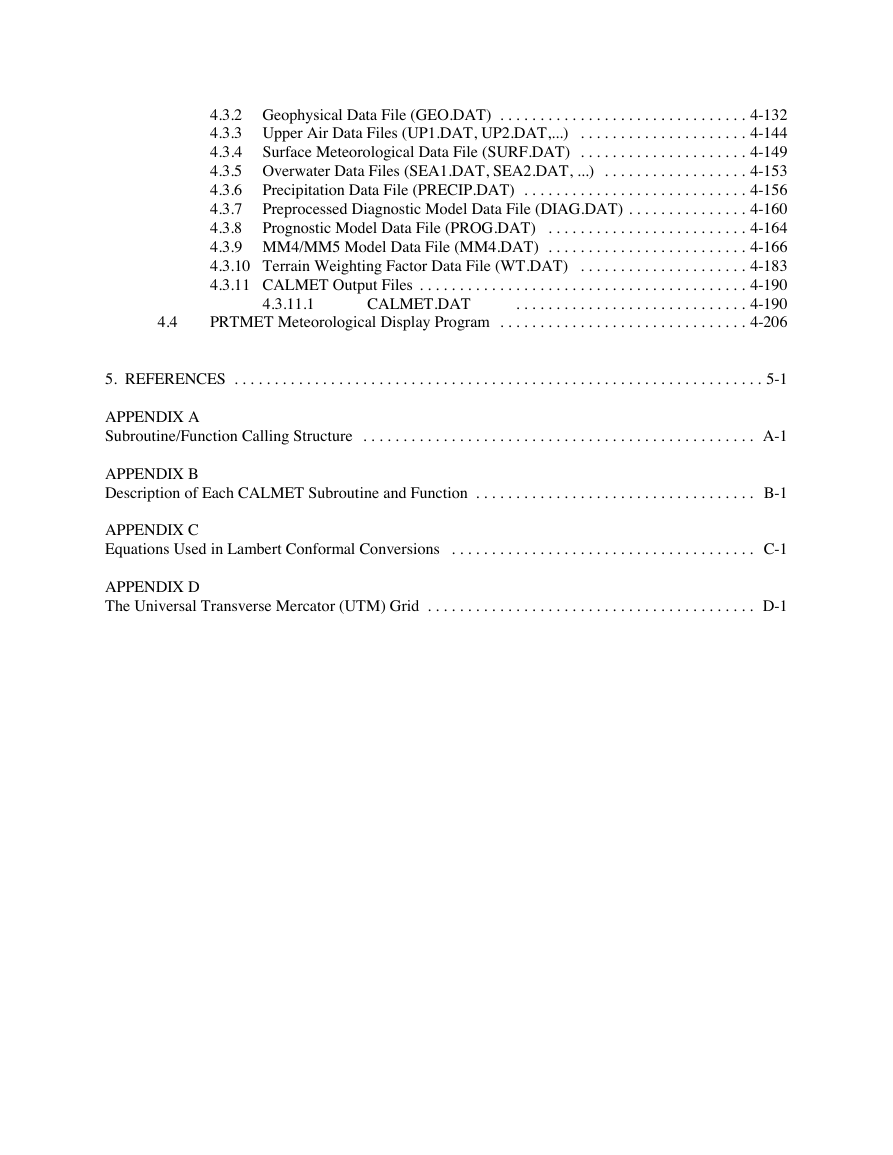

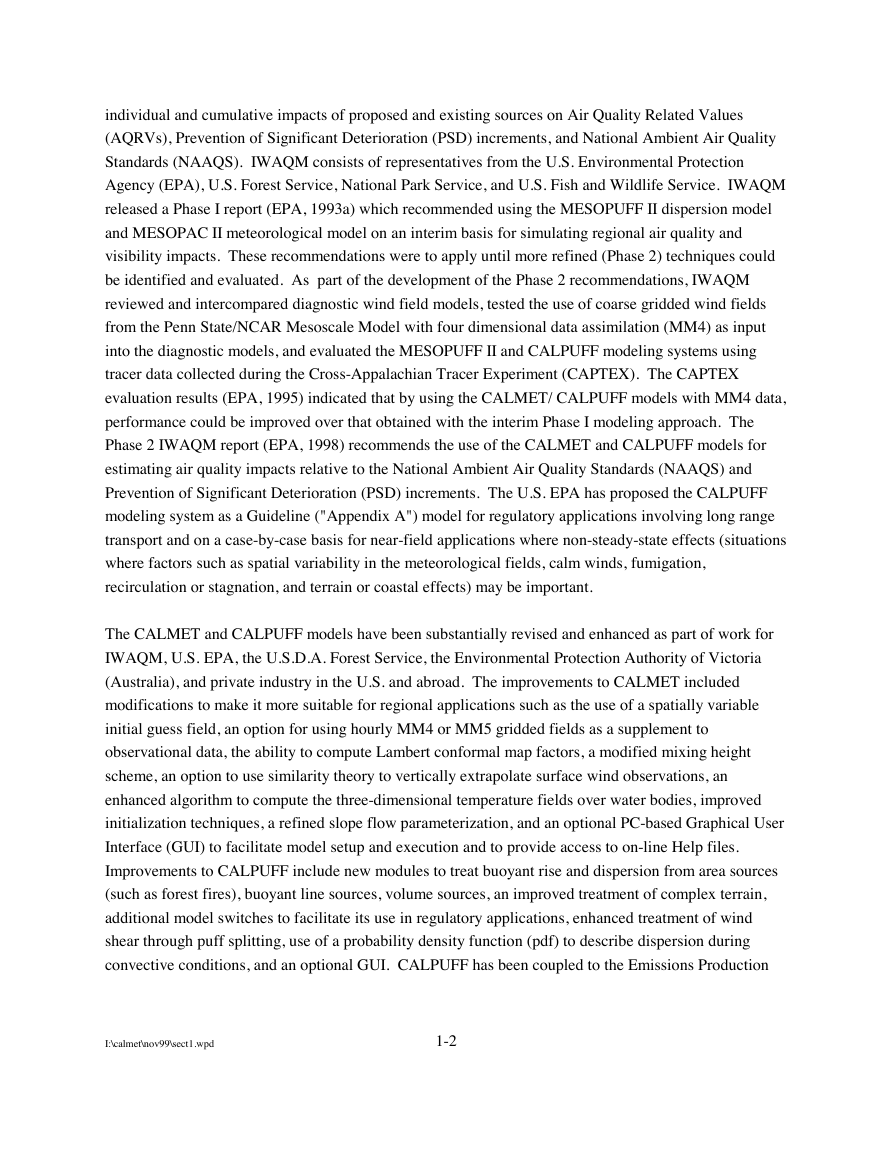
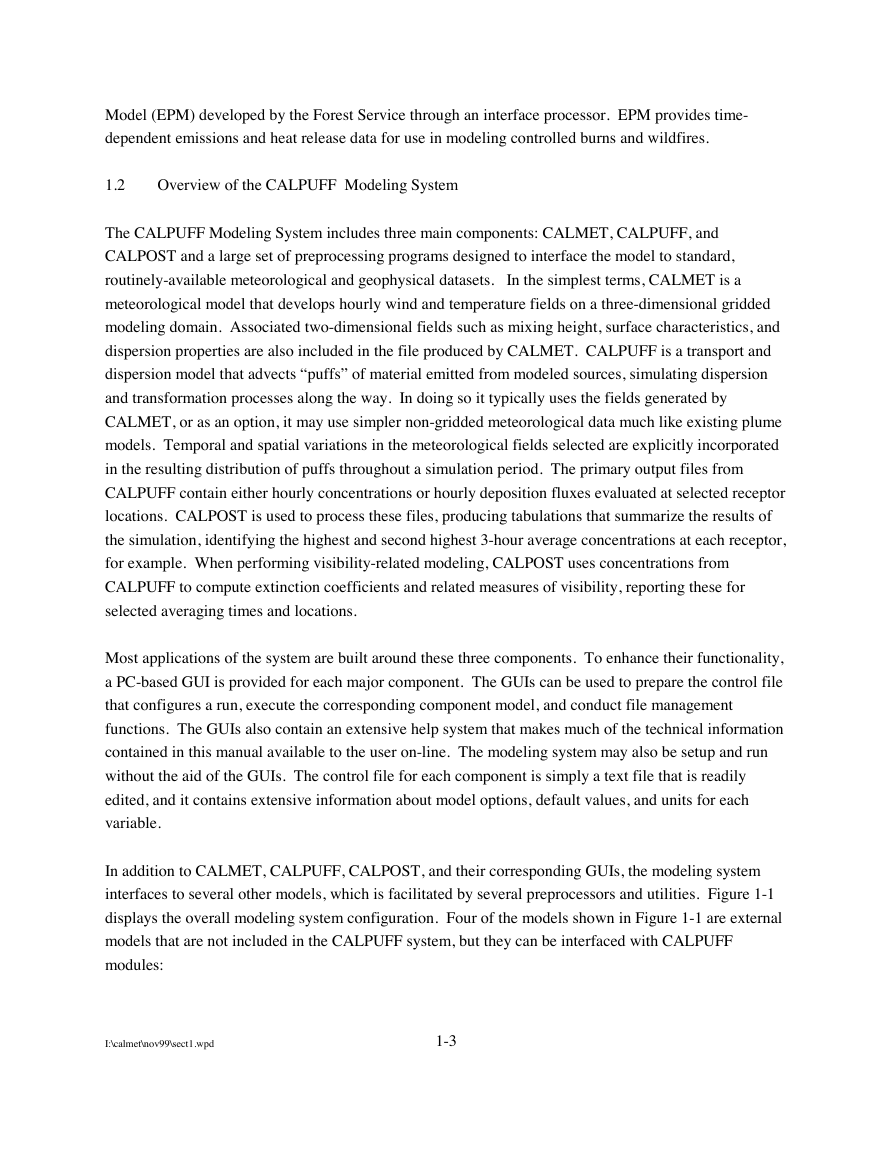

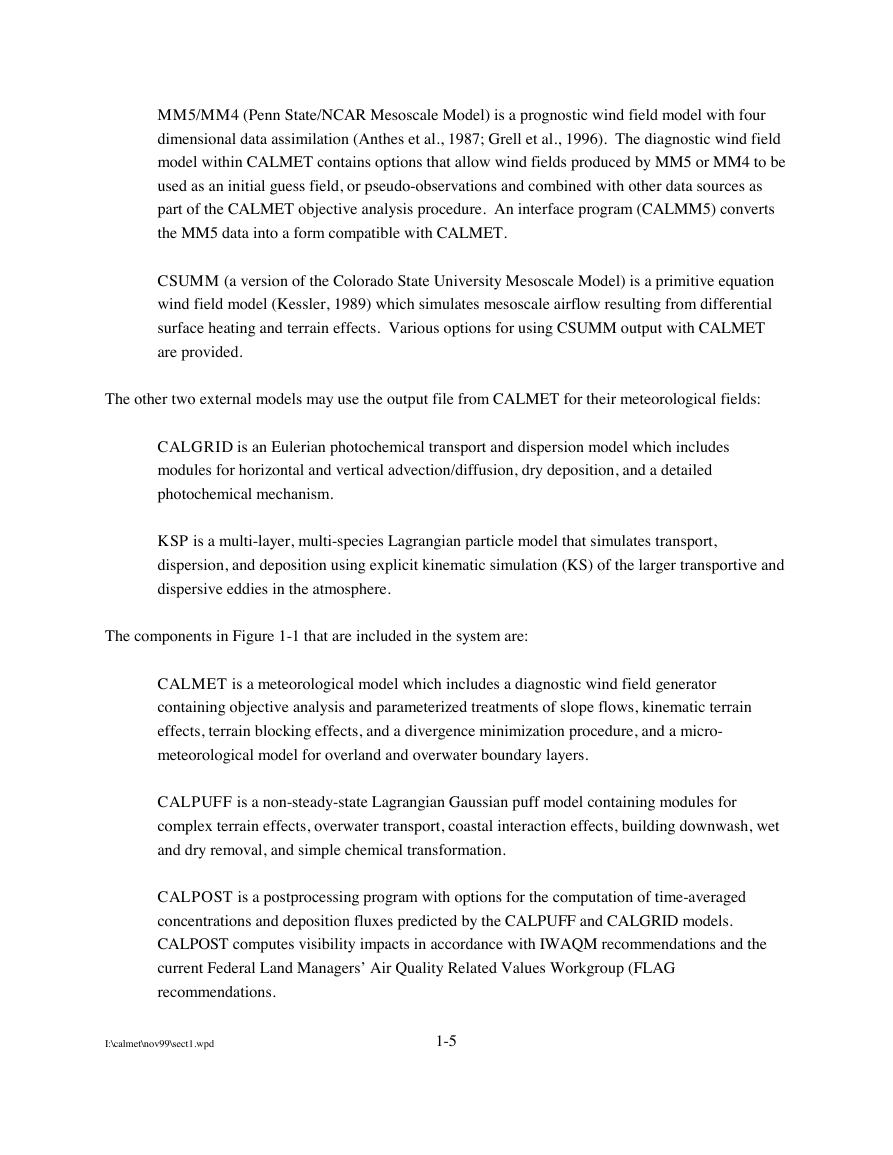








 2023年江西萍乡中考道德与法治真题及答案.doc
2023年江西萍乡中考道德与法治真题及答案.doc 2012年重庆南川中考生物真题及答案.doc
2012年重庆南川中考生物真题及答案.doc 2013年江西师范大学地理学综合及文艺理论基础考研真题.doc
2013年江西师范大学地理学综合及文艺理论基础考研真题.doc 2020年四川甘孜小升初语文真题及答案I卷.doc
2020年四川甘孜小升初语文真题及答案I卷.doc 2020年注册岩土工程师专业基础考试真题及答案.doc
2020年注册岩土工程师专业基础考试真题及答案.doc 2023-2024学年福建省厦门市九年级上学期数学月考试题及答案.doc
2023-2024学年福建省厦门市九年级上学期数学月考试题及答案.doc 2021-2022学年辽宁省沈阳市大东区九年级上学期语文期末试题及答案.doc
2021-2022学年辽宁省沈阳市大东区九年级上学期语文期末试题及答案.doc 2022-2023学年北京东城区初三第一学期物理期末试卷及答案.doc
2022-2023学年北京东城区初三第一学期物理期末试卷及答案.doc 2018上半年江西教师资格初中地理学科知识与教学能力真题及答案.doc
2018上半年江西教师资格初中地理学科知识与教学能力真题及答案.doc 2012年河北国家公务员申论考试真题及答案-省级.doc
2012年河北国家公务员申论考试真题及答案-省级.doc 2020-2021学年江苏省扬州市江都区邵樊片九年级上学期数学第一次质量检测试题及答案.doc
2020-2021学年江苏省扬州市江都区邵樊片九年级上学期数学第一次质量检测试题及答案.doc 2022下半年黑龙江教师资格证中学综合素质真题及答案.doc
2022下半年黑龙江教师资格证中学综合素质真题及答案.doc